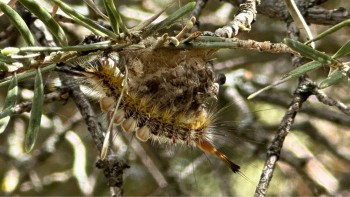-
Douglas-Fir Tussock Moth Outbreak
Recently browned trees to the south of Taos, N.M., are the result of an outbreak of Douglas-fir tussock moths, which are currently in their larval (caterpillar) stage. Proceed with caution when around them.
Image
((USDA Forest Service photo by Zach Behrens)) Specific locations include general forest areas along Highway 518 south of Pot Creek and along Forest Road 476.
An allergic reaction called tussockosis can occur from direct contact with the hairs of the caterpillars, which has thousands of them. And those hairs can go airborne, unseen to the eye. Hairs are also found on female moths, egg masses, and cocoons.
Tussockosis severity may vary between individuals, by the amount of exposure, and the level of the outbreak.
Symptoms may include itchiness, skin rashes, skin irritation, watery eyes, runny nose, and sneezing. More severe reactions, though less common, include blisters, coughing, shortness of breath, wheezing, and chest tightness.
If contact does occur, immediately wash the area of exposure. If symptoms become severe or problematic, immediately seek medical care.
Alert Start Date: May 23rd, 2025
Alert End Date: N/A


